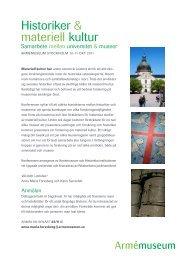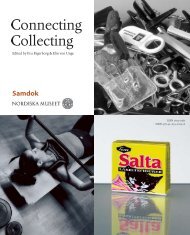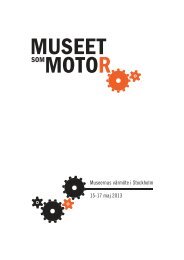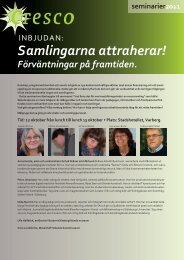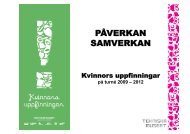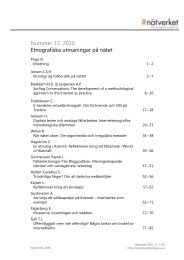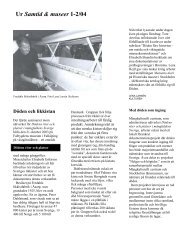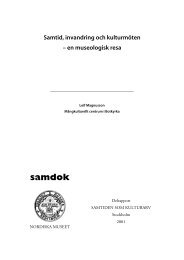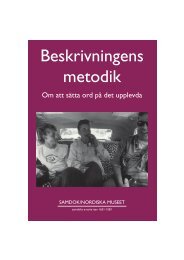Connecting Collecting - Sveriges Museer
Connecting Collecting - Sveriges Museer
Connecting Collecting - Sveriges Museer
Create successful ePaper yourself
Turn your PDF publications into a flip-book with our unique Google optimized e-Paper software.
The Pool for Domestic LifeWhat kind of life is lived behind the door in the suburbs, in a residential area, or in a smallvillage in the remote forest? And what does it look like inside? The task of the Pool for DomesticLife is to explore and document people’s homes and domestic life in contemporary Sweden fromdifferent perspectives.with the way we create a sense of homein a different environment, the hall ofresidence, examining attitudes to housingand visions of the future. The projectreceived financial support from the studenthousing company AF Bostäder inLund, to mark its 50th anniversary in2004.The participating museums carry outmany projects like The Corridor, basedon the conditions and needs of the individualmuseum, and not infrequentlywith external finance. In these contextsthe Samdok organization plays a crucialpart, as support and as a soundingboard.Consuming a homeA theme that has been in the foregroundfor the work of the pool in recent years isthe home in the post-modern consumersociety. This is an interest we share withthe Pool for Leisure, which is why thetwo pools have had a number of jointmeetings and field seminars. Creatingand choosing, two of the “duties” of theconsumer society, are equally relevantfor questions of domestic life and leisure,and thus served as the point of departurefor two small-scale studies.A year ago it was about IKEA. Altogetherthe field studies in an IKEAstore in Gothenburg gave a multifacetedpicture of what steers people’s purchasesand choices. Trends in interior decorationand lifestyle, people’s views of thehome and its individual design weremixed with insights into shopping as aleisure pursuit.The bathroom as a place for enjoyment,practical functions, and interiordesign aesthetics was the theme of thisspring’s joint effort, with field studies inshops, departments stores, and homes inMalmö and Lund. Bathroom makeoversare the latest trend in interior decoration.Here consumption and do-ityourselfare combined with ideas abouta special place in the home where onecan wind down and prepare to wind upagain. With the bathroom study we alsowanted to illuminate the polarizationbetween the dream images of marketingand the factual circumstances of reality.In the bathroom it is not just a matterof changing the fixtures but perhapsabove all of giving the little space newfunctions. At least in advertising, thebathroom is represented as being simultaneouslya place for display to visitorsand a place to which you can retreat andrelax, to devote some time to yourselfafter an active day. The advertisementsfrequently talk about the bathroom interms of “a spa of your own”, and thereader is confronted with pictures offresh-looking people wrapped in bigwhite towels, chatting on the edge of thebathtub.When regarded in a slightly broaderperspective, the transformation of Swedishbathrooms is about how the newconsumerism contributes to changingthe content and meaning of the home.On the one hand, it is virtually a citizen’sduty today to consume, and possible andobligatory changes of the home are oneof the strongest incentives for the individual’sconsumption. At the same time,and this may seem paradoxical, thismass consumption gives the individualthe possibility to shape the home exactlyas he or she wants it. The home becomesa space for display, where not only aperson’s social position but also, andperhaps especially, personal identity andpreferences are expected to take shape.Refugee centre in Bräcke. Photo Björn Oskarsson©Jämtland County MuseumChangeable homesIt is at the interface between the privatehome and the social and culturalcircumstances that the Pool for DomesticLife has its field of operation. Thehome, and the family, are often perceivedas stable institutions. When theconstruction of the modern welfarestate took shape in the post-war years,the home, with the nuclear family asthe foundation of society, was one ofthe places where the political ambitionshad their most palpable expression.Rationalization was to be achieved here,good habits were to be implemented,and breaches of norms were to be combated.Today the home and the familyare phenomena that can be described asa throng of constellations and variationsof a cultural, social, ethnic, and sexualkind that teach us through their very existencethat what we tend to perceive asthe solidity of existence is in fact characterized,if not by fragility, then at least byconstant change. That is why the homeis also a culture-producing space of thegreatest importance for museums orientedto the present day. pMikael Eivergård was formerly head antiquarianat Jämtland County Museum and chair ofthe Pool for Domestic Life and is now publichealth planning officer at The Swedish NationalInstitute of Public Health,mikael.eivergard@fhi.seJohan Knutsson is curator at the NordiskaMuseet and secretary of the Pool for DomesticLife, johan.knutsson@nordiskamuseet.seSamtid & museer no 2/07 • 9



